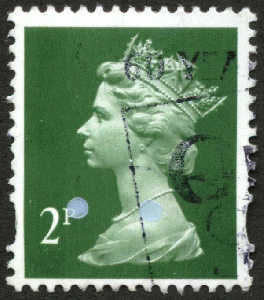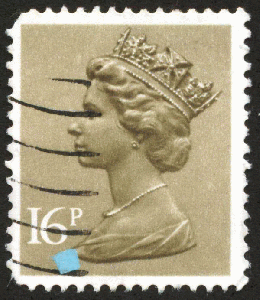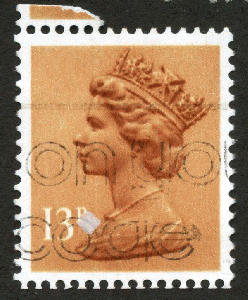@ petzlaff
[#3]Falls der Link, der bei unseren Kollegen im BDPH Forum angegesprochen wurde, mal ins Leere laufen sollte, die Auflösung aus dem "Postage Stamp Chat Board & Stamp Bulletin Board Forum" (Autor: Karl "footysphere", August 2010), Thread "Please help explain these colored shapes on GB Machin stamps" [1] als
originaltextliche "Sicherheitskopie". ;-)
Zwar in Englisch und ich habe jetzt keine Lust den Text noch zu übersetzten, aber im etwaigen Bedarfsfall kann man ja den Googleübersetzter mit heranziehen. ;-))
Gruß
Thomas




Gleicher Beitrag wie [1], Einsteller: "skilo54" & "Global Administrator, The Sheriff" (links)
I used to work for Royal Mail Letters back in the early to mid-eighties at the Sheffield Mechanised Letter Office (MLO). One of my jobs was to 'code' the postcode onto envelopes so a machine, unimaginatively called a mechanised sorting machine (MSM), could read the code and sort letters by destination.
There were two rows of coding desks with about 20 desks in each row. Each desk had an operator or 'coder'. Only a Postman Higher Grade (PHG) could be a coder. This was the grade above Postman and one below the first management grade of Postal Executive Grade D (PED). A coder received 4-weeks training in touch-typing and the keyboard we used was similar to a QWERTY keyboard but with some adaptations.
A newly trained coder was allowed a settling in period in which his workrate was monitored with the expectation that within 4-6 weeks s/he should be doing as a minimum 2000 items per hour with an occupancy of 80%. The occupancy was a measure of how long the coder was sat at his desk actually coding. Many coders held informal competitions to see how high they could get their hourly throughput. I once managed 3500 per hour which wasn't too shabby. However during the eighties industrial relations between the RM management and the workforce were shocking to say the least.
Most of the time we kept our workrate to the bare minimum required. To get 2000 per hour with bang on 80% occupancy for the week was considered to be the holy grail and something that was quite difficult as you had to constantly measure your own performance and amend your coding speed accordingly. Occupancy was a more difficult matter altogether because you had to take into account stoppages due to machinery breakdowns and blockages. You had to work out how long the coding system was up and running and then calculate 80% of that. It took some doing believe you me and was actually harder work than just mindlessly bashing away at the keyboard.
As for the actual coding process itself the letters, already cancelled and faced were fed into the front of the coding desk. These were orientated so that they were fed across an easel in front of the operator who read the postcode and typed it into a keyboard. The letters moved across the operator's easel from right to left at whatever speed s/he was coding at. If s/he stopped coding the easel would stop. Each time a letter was coded it would enter the desk at the lefthand side and there would be a clunk as the machinery applied the phosphor dots.
If the letter had the full postcode two lines of phosphor dots were produced. The bottom line was the outward part of the postcode ie SW10, LU7, HP12 or whatever. This sorted the letter according to post town or post town district. Some bulk mail destinations had their own specific postcode. The DVLA in Swansea for example was SA99.
The top line of dots was the inward part or three-character part of the postcode. This sorted the letter according to the walk (postman's delivery round) the destination was on. Again bulk destinations had different inward codes to differentiate between departments or buildings. The DVLA had a series of inward codes alongside the main SA99 outward code that sorted letters according to dept or section.
If a letter didn't have a postcode the operator could 'pass' it. This letter would then enter the manual sorting stream. However if the operator was experienced and had knowledge of the UK's postcode system s/he could code the outward or part of the outward postcode to ensure that the letter was mechanically sorted.
For example a letter to Sheffield could just be coded with the letter 'S', Redhill with 'RH' etc etc. More experienced operators could code non-postal towns. For example Worksop in Nottinghamshire has a Sheffield postcode. If an experienced coder saw a letter for Worksop without a postcode he could code 'S80' which would mechanically sort the letter to the correct destination.
All coded letters would drop onto a conveyor that run at the front of the bank of coding desks and enter a big machine at the end which would sort the letters according to size. These would then be transported manually to the MSMs for outward sorting into the post towns.
First class mail was processed 12 noon until 10pm and second class mail was process 10pm until 12 noon.
Of course mechanisation has moved on a lot now. Even during the mid-eighties the PO was experimenting with Optical Character Recognition (OCR) machines. These were able to read a printed postocde and apply the phospor, making the coder redundant. However at this time they couldn't read hand written codes and even a lot of printed or type written letters were rejected as unreadable. I imagine this technology has vastly improved since I worked for the Post Office.
So a bit of trip down memory lane for me. I hope it's given you some insight into how the phsophor dots were applied to the letters and why.
Just to add to the above. The phosphor dots, in my time working for the PO (1984-1992), were applied to the bottom right of envelopes, just below where the postcode should be and the top line of dots (inward part of postcode) cut through the main body of the address.
If you have have any stamps with phosphor dots on them this means that the letter was misaligned in the machinery as it went through to have the dots applied. This would mean that the letter would have to enter the manual sorting stream as an MSM wouldn't be able to read the phosphor dot pattern.
Blockages due to misaligned letters were very common and hundreds of letters each day were damaged in the machinery. Damaged letters were sent to the, wait for it, 'damaged letters section', where a PHG would attempt to repair the envelope in order to keep the contents safe for the rest of their journey.
We used this awful brown sticky tape that was overprinted with the PO crown and some official wording. It wasn't self-adhesive, you had to lick it to stickify it and it tasted awful, really awful. Basically your important letter was bodged back together with some cheap sticky tape. The tape and envelope were then stamped to show that it had been 'officially handled' and sent on it's way, first class of course regardless of the postage rate you'd paid.
Eventually we were issued with some nice white self-adhesive official repair tape which looked a lot better and then this was eventually discontinued and we got clear branded plastic bags to put damaged items in, together with a 'we are very sorry' note.
It has to be said that some letters that caused the damage did have coins or other similar inserts in them but equally so just normal flat envelopes got mashed up beyond recognition purely because of the mechanised sorting system's flaws. Unfortunately some letters and their contents were beyond repair and these were just binned as confidential waste as neither sender nor addressee were apparent due to the damage caused.
_________________
cheers, Karl[1]:
http://www.stampboards.com/viewtopic.php?f=10&t=20086&p=811634